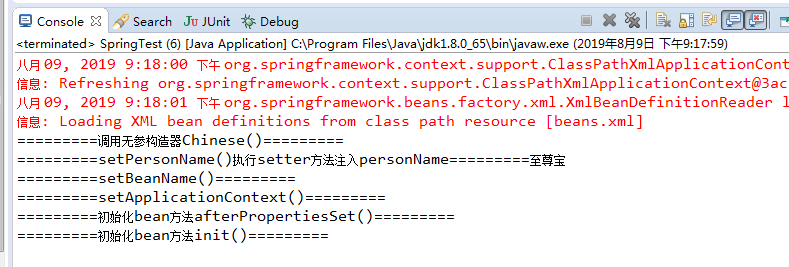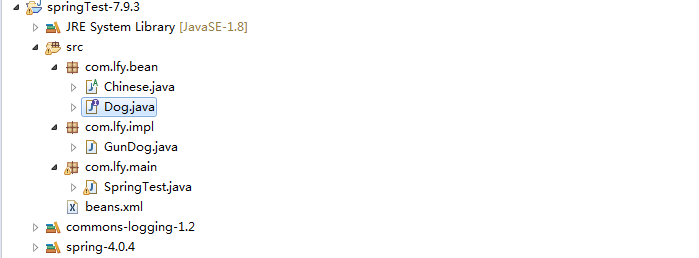spring-第八篇之容器中的bean的生命周期
1、容器中的bean的生命周期
spring容器可以管理singleton作用域的bean的生命周期,包括bean何时被创建、何时初始化完成、何时被销毁。客户端代码不能控制该类型bean的销毁。spring容器可以管理该类型bean在实例化结束之后和销毁之前的行为。
prototype作用域类型的bean则完全交由客户端代码管理,spring容器仅仅是负责创建bean。spring容器无法管理该类型的bean。
管理bean的生命周期行为的主要时机有以下两个:
1》注入依赖关系之后
2》即将销毁bean之前
2、依赖关系注入之后的行为
spring提供两种方式在bean全部属性设置成功后执行特定的行为:
1》使用init-method属性,指定某方法在在bean全部属性(即包括依赖)设置成功后执行特定行为。
2》实现InitializingBean接口,并实现该接口的void afterPropertiesSet() throws Exception方法。
举个例子:

Chinese.java
package com.lfy.bean; import org.springframework.beans.BeansException;
import org.springframework.beans.factory.BeanNameAware;
import org.springframework.beans.factory.InitializingBean;
import org.springframework.context.ApplicationContext;
import org.springframework.context.ApplicationContextAware; public class Chinese implements InitializingBean,BeanNameAware,ApplicationContextAware { private ApplicationContext ctx;
private String beanName;
private String personName; public Chinese() { System.out.println("=========调用无参构造器Chinese()=========");
} @Override
public void setBeanName(String beanName) { this.beanName=beanName;
System.out.println("=========setBeanName()=========");
} @Override
public void setApplicationContext(ApplicationContext arg0) throws BeansException { this.ctx=arg0;
System.out.println("=========setApplicationContext()=========");
} /**
* 生命周期方法
*/
@Override
public void afterPropertiesSet() throws Exception { System.out.println("=========初始化bean方法afterPropertiesSet()=========");
} /**
* 将被设为生命周期方法
*/
public void init() { System.out.println("=========初始化bean方法init()=========");
} public void setPersonName(String name) { this.personName=name;
System.out.println("=========setPersonName()执行setter方法注入personName========="+personName);
} public void info() { System.out.println("Chinese实现类"+",部署该bean时指定的id为:"+beanName);
} }
beans.xml
<?xml version="1.0" encoding="UTF-8"?>
<!-- spring配置文件的根元素,使用spring-beans-4.0.xsd语义约束 -->
<beans xmlns:xsi="http://www.w3.org/2001/XMLSchema-instance"
xmlns="http://www.springframework.org/schema/beans"
xsi:schemaLocation="http://www.springframework.org/schema/beans
http://www.springframework.org/schema/beans/spring-beans-4.0.xsd"> <bean id="chinese" class="com.lfy.bean.Chinese" init-method="init">
<property name="personName" value="至尊宝"/>
</bean>
</beans>
SpringTest.java
package com.lfy.main; import org.springframework.context.ApplicationContext;
import org.springframework.context.support.ClassPathXmlApplicationContext; import com.lfy.bean.Chinese; /**
* 获得bean本身的id
* @author lfy
*
*/
public class SpringTest { public static void main(String[] args) { ApplicationContext ctx=new ClassPathXmlApplicationContext("beans.xml"); Chinese chin=ctx.getBean("chinese", Chinese.class);
} }
运行结果:

总结:上面的例子,两种方式都同时实现了,注意它们执行的顺序。afterPropertiesSet()方法先于init()方法得到执行。
3、bean销毁之前的行为
spring提供两种方式在bean实例销毁之前执行特定的行为:
1》使用destroy-method属性,指定某方法在在bean实例销毁之前执行特定行为。
2》实现DisposableBean接口,并实现该接口的void destroy() throws Exception方法。
举个例子:对前面的例子做一些修改
Chinese.java
package com.lfy.bean; import org.springframework.beans.BeansException;
import org.springframework.beans.factory.BeanNameAware;
import org.springframework.beans.factory.DisposableBean;
import org.springframework.beans.factory.InitializingBean;
import org.springframework.context.ApplicationContext;
import org.springframework.context.ApplicationContextAware; public class Chinese implements InitializingBean,DisposableBean,BeanNameAware,ApplicationContextAware { private ApplicationContext ctx;
private String beanName;
private String personName; public Chinese() { System.out.println("=========调用无参构造器Chinese()=========");
} @Override
public void setBeanName(String beanName) { this.beanName=beanName;
System.out.println("=========setBeanName()=========");
} @Override
public void setApplicationContext(ApplicationContext arg0) throws BeansException { this.ctx=arg0;
System.out.println("=========setApplicationContext()=========");
} /**
* 生命周期方法
*/
@Override
public void afterPropertiesSet() throws Exception { System.out.println("=========初始化bean方法afterPropertiesSet()=========");
} /**
* 将被设为生命周期方法
*/
public void init() { System.out.println("=========初始化bean方法init()=========");
} /**
* 生命周期方法
*/
@Override
public void destroy() throws Exception { System.out.println("=========结束bean前执行方法destroy()=========");
} /**
* 将被设为生命周期方法
*/
public void close() { System.out.println("=========结束bean前执行方法close()=========");
} public void setPersonName(String name) { this.personName=name;
System.out.println("=========setPersonName()执行setter方法注入personName========="+personName);
} public void info() { System.out.println("Chinese实现类"+",部署该bean时指定的id为:"+beanName);
} }
beans.xml
<?xml version="1.0" encoding="UTF-8"?>
<!-- spring配置文件的根元素,使用spring-beans-4.0.xsd语义约束 -->
<beans xmlns:xsi="http://www.w3.org/2001/XMLSchema-instance"
xmlns="http://www.springframework.org/schema/beans"
xsi:schemaLocation="http://www.springframework.org/schema/beans
http://www.springframework.org/schema/beans/spring-beans-4.0.xsd"> <!-- 遇到了个问题,偶尔出现destory-method="close"不能出现在<bean.../>,暂未明白原因 -->
<bean id="chinese" class="com.lfy.bean.Chinese" init-method="init" destory-method="close">
<property name="personName" value="至尊宝"/>
</bean>
</beans>
SpringTest.java
package com.lfy.main; import org.springframework.context.support.AbstractApplicationContext;
import org.springframework.context.support.ClassPathXmlApplicationContext; import com.lfy.bean.Chinese; /**
* 获得bean本身的id
* @author lfy
*
*/
public class SpringTest { public static void main(String[] args) { AbstractApplicationContext ctx=new ClassPathXmlApplicationContext("beans.xml"); Chinese chin=ctx.getBean("chinese", Chinese.class); ctx.registerShutdownHook();
} }
运行结果:

总结:由于xml解析发生了些问题未能找到原因,一开始destory-method方法没能演示效果。后来突然又好了,可能是eclipse的问题。在非Web应用上,使用registerShutdownHook()能够正确的关闭spring容器。并且注意destory()方法先于close()方法执行。
4、此外协调作用域不同步的bean:
singleton作用域的bean依赖于prototype作用域的bean,但singleton bean只有一次初始化的机会,在初始化单例bean的时候,会先创建prototype作用域的bean,然后再初始化单例bean。这将导致以后无论什么时候通过单例bean访问prototype bean都会是同一个bean,相当于单例bean变相的将prototype bean单例化了。
为了解决这种生命周期与预期不同步的问题,有两种解决思路:
1》 放弃依赖注入:单例bean每次需要prototype bean时,主动向容器请求新的bean实例。
2》利用方法注入:通常使用lookup方法注入。使用lookup方法注入可以让spring容器重写容器中bean的抽象或者具体方法,返回查找容器中其他bean的结果。spring通过使用JDK动态代理或cglib库修改客户端的二进制代码,从而实现上述需求。
使用lookup方法注入,大致的步骤有:
1》将调用者bean的实现类定义为抽象类,并定义一个抽象方法来获取被依赖的bean。
2》在<bean.../>元素中添加<lookup-method.../>子元素让spring为调用者bean的实现类实现指定的抽象方法。
3》使用<lookup-method.../>元素需要指定如下两个元素:
name:指定需要让spring实现的方法。
bean:指定spring实现该方法的返回值。
举个例子:

Dog.java
package com.lfy.bean;
public interface Dog {
public String run();
}
GunDog.java
package com.lfy.impl;
import com.lfy.bean.Dog;
public class GunDog implements Dog {
private String name;
public void setName(String name) {
this.name=name;
}
@Override
public String run() {
return "我是一只叫"+this.name+"的猎犬,奔跑迅速...";
}
}
Chinese.java
package com.lfy.bean;
public abstract class Chinese {
//private Dog dog;留作动态注入一个Dog的实例
// 定义抽象方法,该方法用于获取被依赖的bean
public abstract Dog getDog();
public void hunt() {
System.out.println("我带着:"+getDog()+"出去打猎");
System.out.println(getDog().run());
}
}
beans.xml
<?xml version="1.0" encoding="UTF-8"?>
<!-- spring配置文件的根元素,使用spring-beans-4.0.xsd语义约束 -->
<beans xmlns:xsi="http://www.w3.org/2001/XMLSchema-instance"
xmlns="http://www.springframework.org/schema/beans"
xsi:schemaLocation="http://www.springframework.org/schema/beans
http://www.springframework.org/schema/beans/spring-beans-4.0.xsd"> <!-- chinese依赖于gunDog,并且为单例bean依赖prototype实例。
spring检测到lookup-method元素,会自动为该元素的name属性
指定的方法提供实现体
-->
<bean id="chinese" class="com.lfy.bean.Chinese">
<lookup-method name="getDog" bean="gunDog"/>
</bean> <!-- 指定bean的作用域为prototype,希望每次都是新的bean -->
<bean id="gunDog" class="com.lfy.impl.GunDog" scope="prototype">
<property name="name" value="旺财"/>
</bean>
</beans>
SpringTest.java
package com.lfy.main; import org.springframework.context.ApplicationContext;
import org.springframework.context.support.AbstractApplicationContext;
import org.springframework.context.support.ClassPathXmlApplicationContext; import com.lfy.bean.Chinese; /**
* 获得bean本身的id
* @author lfy
*
*/
public class SpringTest { public static void main(String[] args) { ApplicationContext ctx=new ClassPathXmlApplicationContext("beans.xml"); Chinese p1=ctx.getBean("chinese", Chinese.class);
Chinese p2=ctx.getBean("chinese", Chinese.class);
System.out.println("是否还是同一个Chinese猎人:"+(p1 == p2));
p1.hunt();
p2.hunt();
} }
运行结果:

总结:我们的Chinese类是一个抽象类,它不能实例化。我们通过给它添加<lookup-method.../>元素,告诉spring需要实现哪个抽象方法spring容器为抽象方法提供实体后,抽象方法变成类的具体方法,这个类也就变成了具体类,接下来spring就可以创建该bean的实例了。
spring会采用运行时动态增强的方式来实现<lookup-method.../>元素所指定的抽象方法:如果目标抽象类实现过接口,spring会采用JDK动态代理来实现该抽象类,并为之实现抽象方法;如果目标抽象类没有实现过接口,spring会采用cglib实现该抽象类,并为之实现抽象方法。spring-4.0.4已经在核心包中集成了cglib类库,无需额外添加cglib的jar包。
spring-第八篇之容器中的bean的生命周期的更多相关文章
- SpringBean容器启动流程+Bean的生命周期【附源码】
如果对SpringIoc与Aop的源码感兴趣,可以访问参考:https://javadoop.com/,十分详细. 目录 Spring容器的启动全流程 Spring容器关闭流程 Bean 的生命周期 ...
- Spring扩展:替换IOC容器中的Bean组件 -- @Replace注解
1.背景: 工作中是否有这样的场景?一个软件系统会同时有多个不同版本部署,比如我现在做的IM系统,同时又作为公司的技术输出给其他银行,不同的银行有自己的业务实现(比如登陆验证.用户信息查询等) ...
- spring中的bean的生命周期
bean的生命周期:bean的创建 —— 初始化 ——销毁的过程 容器管理bean的生命周期,我们可以自定义初始化和销毁方法,容器在bean进行到当前生命周期就会调用我们的方法 在xml配置文件中是在 ...
- Spring重点—— IOC 容器中 Bean 的生命周期
一.理解 Bean 的生命周期,对学习 Spring 的整个运行流程有极大的帮助. 二.在 IOC 容器中,Bean 的生命周期由 Spring IOC 容器进行管理. 三.在没有添加后置处理器的情况 ...
- Spring Bean的生命周期,《Spring 实战》书中的官方说法
连着两天的面试 ,都问到了 Spring 的Bean的生命周期,其中还包括 昨晚一波阿里的电话面试.这里找到了Spring 实战中的官方说法.希望各位要面试的小伙伴记住,以后有可能,或者是有时间 去看 ...
- 简:Spring中Bean的生命周期及代码示例
(重要:spring bean的生命周期. spring的bean周期,装配.看过spring 源码吗?(把容器启动过程说了一遍,xml解析,bean装载,bean缓存等)) 完整的生命周期概述(牢记 ...
- 【Spring】Spring中的Bean - 4、Bean的生命周期
Bean的生命周期 简单记录-Java EE企业级应用开发教程(Spring+Spring MVC+MyBatis)-Spring中的Bean 了解Spring中Bean的生命周期有何意义? 了解Sp ...
- Spring基础14——Bean的生命周期
1.IOC容器中的Bean的生命周期方法 SpringIOC容器可以管理Bean的生命周期,Spring允许在Bean生命周期的特定点执行定制的任务.SpringIOC容器对Bean的生命周期进行管理 ...
- Spring学习-- IOC 容器中 bean 的生命周期
Spring IOC 容器可以管理 bean 的生命周期 , Spring 允许在 bean 声明周期的特定点执行定制的任务. Spring IOC 容器对 bean 的生命周期进行管理的过程: 通过 ...
随机推荐
- grunt默认只允许localhost和访问,如何设置外部IP地址访问
转载请注明出处: 猩猩队长 http://www.cnblogs.com/wayns/p/access_grunt_server_from_outside.html 使用Yeoman生成器创建web ...
- win32 socket编程(五)——客户端实例(TCP)
一.客户端操作流程 1.1 加载套接字库(WSAStartup()) 1.2创建套接字(socket()). 1.3向服务器发出连接请求(connect()). 对于客户端来说,它不需要绑定,可以直接 ...
- Linux安装Sqoop及基础使用
下载Sqoop 官网地址 http://sqoop.apache.org/ wget http://mirrors.hust.edu.cn/apache/sqoop/1.4.7/sqoop-1.4.7 ...
- 2018-11-15-UWP-how-to-get-the-touch-width
title author date CreateTime categories UWP how to get the touch width lindexi 2018-11-15 18:49:12 + ...
- 【学习】005 线程池原理分析&锁的深度化
线程池 什么是线程池 Java中的线程池是运用场景最多的并发框架,几乎所有需要异步或并发执行任务的程序 都可以使用线程池.在开发过程中,合理地使用线程池能够带来3个好处. 第一:降低资源消耗.通过重复 ...
- 美国的科技公司是如何使用加密的DNS
加密设备和“以隐私为中心”的提供商之间的DNS流量可以阻止某人窥探您的浏览器所指向的位置,或者使用DNS攻击将其发送到其他地方. 该网络中立性的死亡和法规对互联网服务供应商如何处理客户的网络流量的松动 ...
- Java常用类库API之数字处理工具类
数字处理工具类BigDecimal和DecimalFormat Java提供的java.text.DecimalFormat类,帮助我们用最快的速度将数据格式化为我们想要的样子.例如,取两位小数 im ...
- 22.Express框架——2019年12月19日
2019年12月19日14:16:36 1. express简介 1.1 介绍 Express框架是后台的Node框架,所以和jQuery.zepto.yui.bootstrap都不一个东西. Exp ...
- Python---基础---循环,函数
2019-05-21 ----------------------------------- # 打印出一个矩形# 控制行for i in range(1, 5): #控制列 for j ...
- POJ 1502 MPI MaeIstrom ( 裸最短路 || atoi系统函数 )
题意 : 给出 N 个点,各个点之间的路径长度用给出的下三角矩阵表示,上上角矩阵和下三角矩阵是一样的,主对角线的元素都是 0 代表自己到达自己不用花费,现在问你从 1 到 N 的最短路,矩阵的 x 代 ...
